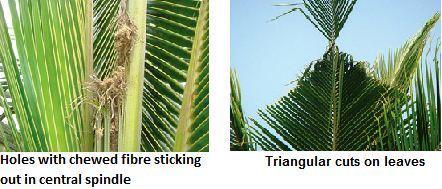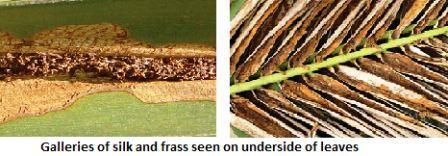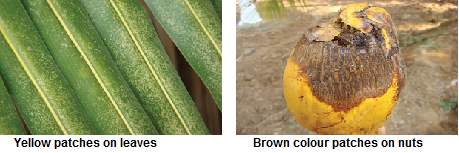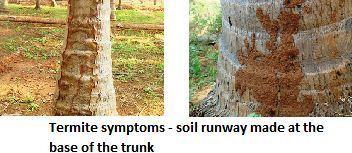Coconut: Insect, Mite and Nematode Pests
Coconut: Insect, Mite and Nematode Pests
Rhinoceros beetle
Biology:- Egg: Females lays 140 - 150 oval creamy white eggs in manure pits or decaying vegetable matter at a depth of 5 to 15 cm. Egg periods is 8 to 18 days.
- Grub: Grub is stout, sluggish, white “C”-shaped with pale brown head and found at a depth of 5 to 30 cm.
- Pupa: Grub pupates in earthen cells at a depth of 0.3 to 1 m
- Adult: Adult beetle is stout, brownish black or black and has a long horn projecting dorsally from the head in male. Horn is short in female.
 The adult beetle bores into the unopened fronds and spathes. Damage by the pest leads to 10 to 15% loss in yield
The adult beetle bores into the unopened fronds and spathes. Damage by the pest leads to 10 to 15% loss in yield- The attacked frond when fully opened shows characteristic triangular cuts.
- Central spindle appears cut or toppled
- Fully opened fronds showing characteristic diamond shaped cuttings
- Holes with chewed fibre sticking out at the base of central spindle.
- Predator: Reduviid bug
Red palm weevil
Biology:- Egg: Oval and creamy white in colour. Eggs laid in scooped out small cavities, wounds and other cut injuries on the trunk
- Grub: Light yellowish grub without legs. Stout, fleshy and apodous with a conical body bulged in middle and tapering towards the end
- Pupa: The full frown larva pupates inside the stem and fibrous cocoon made out of fibrous strands
- Adult: Reddish brown weevil has six dark spots on thorax. Male has conspicuous long snout has a tuft of hairs
 Red palm weevil is one of the most destructive pests of coconut, oil palms and ornamental palms
Red palm weevil is one of the most destructive pests of coconut, oil palms and ornamental palms- The hole can be seen on the stem with chewed up fibres protruding out.
- Many times reddish brown liquid can be seen oozing out from the hole.
- The grubs cause damage inside the stem or crown by feeding on soft tissues and often cause severe damage especially when a large number of them bore into the soft, growing parts. In case of severe infestation the inside portion of trunk is completely eaten and become full of rotting fibres.
- In case of young palms the top withers while in older palms the top portion of trunk bends and ultimately breaks at the bend (wilting).
- Sometimes the gnawing sound produced by the feeding grubs inside will also be audible.
- In the advanced stage of infestation yellowing of the inner whorl of leaves occur. The crowns falls down or dry up later when palm is dead.
Black headed caterpillar
Biology: Larva: Caterpillar is greenish brown with dark brown head and prothorax, and a reddish mesothorax. It has brown stripes on the body.
Larva: Caterpillar is greenish brown with dark brown head and prothorax, and a reddish mesothorax. It has brown stripes on the body.- Pupa: It pupates inside the web itself in a thin silken cocoon
- Adult: Greyish white in colour;
- Female: Females are with long antenna and three faint spots on the forewings
- Male: Males are with fringed hairs in hind wings in apical and anal margin.
- The coconut trees of all ages are attacked.
- Dried up patches on leaflets of the lower leaves, only three or four youngest leaves at the center of the grown remain green.
- Galleries of silk and frass on underside of leaflets.
- In case of severe infestation the whole plantations present a scorched appearance.
- Parasitiods: Bracon spp., Ichneumon spp., Goniozus nephantidis, Brachymeria spp. etc.
- Predators: Reduviid bug, spider, red ant, earwig, ground beetle etc.
Coconut eriophyid mite
Biology:- Mites are usually found under the bracts of fertilized female flowers and do not infest the unfertilized flowers. This mite is very minute in size measuring 200 – 250 micron in length and 36 – 52 micron in width with two pairs of legs. Nymph and adult are pale in colour with elongate body and worm like appearance. The life cycle of this mite, which consists of egg, two larval instars and an adult stage, is completed in 7 -10 days.
 The earliest symptom on 2-3 month old buttons is pale yellow triangular patches seen below the perianth.
The earliest symptom on 2-3 month old buttons is pale yellow triangular patches seen below the perianth.- Later, these patches become brown. Severely affected buttons may fall. As the buttons grow, brown patches lead to black necrotic lesions with longitudinal fissures on the husk.
- Oozing of the gummy exudation from the affected surface of the nuts.
- Uneven growth results in distortion and stunting of nuts leading to reduction in copra yield. In severe cases, the nuts are malformed with cracks and hardened husk.
- Predators: Phytoseiid mites, ladybug beetles, syrphid flies, minute pirate bug, Oligota spp., lacewing
Termite
Biology:- Egg: Dull, kidney shaped and hatches in 30-90 days.
- Nymph: Moult 8-9 times and are full grown in 6-12 months.
- Adult: Creamy coloured tiny insects resembling ants with dark coloured head.
- Termites are likely to cause damage to transplanted seedlings particularly in the earlier stage (wilting of seedlings).
- Base of trunks plastered with runways made of soil and fibres.
 EPNs seek out and kill all stages of harmful soil-dwelling insects. They can be used to control a broad range of soil-inhabiting insects and above-ground insects in their soil-inhabiting stage of life. The IJs emerge from cadaver, search for termites, infect, kill and again multiply and remain in the moist soil. Termites which are major pests in sugarcane can be managed by using EPNs effectively. EPN can be produced even at farmer level using either Galleria or Corcyra as a host.
EPNs seek out and kill all stages of harmful soil-dwelling insects. They can be used to control a broad range of soil-inhabiting insects and above-ground insects in their soil-inhabiting stage of life. The IJs emerge from cadaver, search for termites, infect, kill and again multiply and remain in the moist soil. Termites which are major pests in sugarcane can be managed by using EPNs effectively. EPN can be produced even at farmer level using either Galleria or Corcyra as a host.
Nematode
- Among nematodes, burrowing nematode (Radopholus similis) damages the roots of coconut. Burrowing nematode populations survive under field conditions for six months in moist soil (27 to 36°C) and one month in dry soil (29 to 39°C), whereas it survives for 15 months in moist soil (25.5 to 28.5°C) and 3 months in dry soil (27 to 31°C) under greenhouse conditions. The nematode survives in roots of stumps of felled coconut palms up to six months.
- The nematode infested coconut palms exhibit general decline, yellowing, button shedding, and reduction in leaf size.
- The symptoms on roots are more specific.
- Elongated orange colour lesions are seen on tender and semi hard roots.
- Consequent to nematode parasitization and multiplication these lesions enlarge and coalesce to cause extensive rotting of roots.
- Tender roots on heavy infestation become spongy in texture.
IPM for Coconut
To know the IPM practices for Coconut, click here.
Source: NIPHM and Directorate of Plant Protection, Quarantine & Storage
Last Modified : 3/1/2020
© C–DAC.All content appearing on the vikaspedia portal is through collaborative effort of vikaspedia and its partners.We encourage you to use and share the content in a respectful and fair manner. Please leave all source links intact and adhere to applicable copyright and intellectual property guidelines and laws.
RELATED ITEMS
Grapes Pests
This topic covers the information related to Pest ...
Sorghum Pests
This topic covers the information related to Pest ...
Horsegram Insect Pests
This topic covers information about Horsegram Ins...
Horsegram Pests
This topic covers information about Horsegram Pest...
RELATED LANGUAGES
